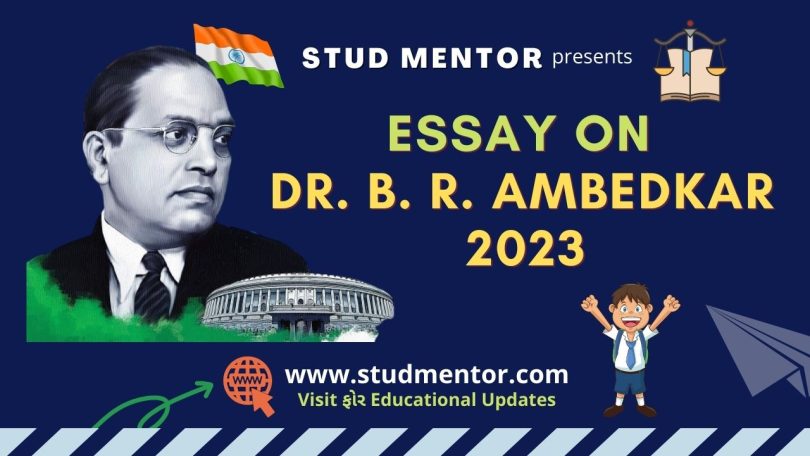Are you searching for – Best Essay on Dr. Bhimrao Ambedkar in English 2023
Then you are at Right Place.
The Complete and Official Information of Best Essay on Dr. Bhimrao Ambedkar in English 2023
Best Essay on Dr. Bhimrao Ambedkar in English
Babasaheb Dr. Bhimrao Ambedkar was born on 14th April, 1891 at Mhow, near Indore in the then Central Province, now Madhya Pradesh. He was the fourteenth child of his parents. The life of Dr. Bhimrao Ambedkar was marked by struggles but he proved that every hurdle in life can be surmounted with talent and firm determination. The biggest barrier in his life was the caste system according to which the family he was born in was considered ‘untouchable’.
In the year 1907, young Bhimrao passed the Matriculation examination from Bombay University with flying colours. Later in 1913 he graduated in Political Science and Economics from Bombay University. Around the same time his father passed away. Although he was going through a bad time, Bhimrao decided to accept the opportunity to go to USA for further studies at Columbia University for which he was awarded a scholarship by the Maharaja of Baroda. Bhimrao remained abroad from 1913 to 1917 and again from 1920 to 1923. During this period he had established himself as an eminent intellectual. Columbia University had awarded him the Ph.D for his thesis, which was later published in a book form under the title “The Evolution of Provincial Finance in British India”. But his first published article was “Castes in India – Their Mechanism, Genesis and Development”. During his stay in London from 1920 to 1923, he also completed his thesis titled “The Problem of the Rupee” for which he was awarded the degree of D.Sc. Before his departure for London he had taught at a College in Bombay.
By the time he returned to India in April 1923, Dr Bhimrao Ambedkar had equipped himself fully to wage war against the practice of untouchability on behalf of the untouchable and the downtrodden. Meanwhile the political situation in India had undergone substantial changes and the freedom struggle in the country had made significant progress. While Bhimrao was an ardent patriot on one hand, he was the saviour of the oppressed, women and poor on the other. He fought for them throughout his life. In 1923, he set up the ‘Bahishkrit Hitkarini Sabha (Outcastes Welfare Association), for spreading education and culture amongst the downtrodden, improving the economic status and raising matters concerning their problems in the proper forums to focus attention on them and finding solutions to the same. The problems of the downtrodden were centuries old and difficult to overcome. Their entry into temples was forbidden. They could not draw water from public wells and ponds. Their admission in schools was prohibited. In 1927, he led the Mahad March at the Chowdar Tank. This marked the beginning of the anti caste and ant-priest movement. The temple entry movement launched by Dr. Ambedkar in 1930 at Kalaram temple, Nasik is another landmark in the struggle for human rights and social justice.
In the meantime, British Prime Minister Ramsay McDonald announced the ‘Communal Award’ as a result of which in several communities including the ‘depressed classes’ were given the right to have separate electorates. This was a part of the overall design of the British to divide and rule. Gandhiji wanted to defeat this design and went on a fast unto death to oppose it. On 24th September 1932, Dr. Ambedkar and Gandhiji reached an understanding, which became the famous Poona Pact. According to this Pact, in addition to the agreement on electoral constituencies, reservations were provided for untouchables in Government jobs and legislative assemblies. The provision of separate electorate was dispensed with. The Pact carved out a clear and definite position for the downtrodden on the political scene of the country. It opened up opportunities of education and government service for them and also gave them a right to vote. Dr. Ambedkar attended all the three Round Table Conferences in London and each time, forcefully projected his views in the interest of the ‘untouchable’. He exhorted the downtrodden sections to raise their living standards and to acquire as much political power as possible. After a while Dr. Ambedkar, organised the Independent Labour Party, participated in the provincial elections and was elected to the Bombay Legislative Assembly. During these days he stressed the need for abolition of the ‘Jagirdari’ system, pleaded for workers Fight to strike and addressed a large number of meetings and conferences in Bombay Presidency. In 1939, during the Second World War, he called upon Indians to join the Army in large numbers to defeat Nazism, which he said, was another name for Fascism.
In 1947, when India became independent, he became the first Law Minister of Indipendent India. Dr. Ambedkar had differences of opinion with the Government over the Hindu Code Bill, which led to his resignation as Law Minister. The Constituent Assembly entrusted the job of drafting the Constitution to a committee and Dr. Ambedkar was elected as Chairman of the Drafting Committee. While he was busy with drafting the Constitution, India faced several crises. In the beginning of 1948, Dr. Ambedkar completed the draft of the Constitution and presented it in the Constituent Assembly. In November 1949, this draft was adopted with very few amendments. Many provisions have been made in the Constitution to ensure social justice for scheduled castes, scheduled tribes and backward classes. Dr. Ambedkar was of the opinion that traditional religious values should be given up and new ideas adopted. He laid special emphasis on dignity, unity, freedom and rights for all citizens as enshrined in the Constitution. Dr. Ambedkar advocated democracy in every field: Social, Economic and Political. For him Social Justice meant maximum happiness to the maximum number of people.
On October 14, 1956 he embraced Buddhism along with many of his followers. The same year he completed his last writing ‘Buddha and His Dharma’. Dr. Ambedkar’s patriotism started with the upliftment of the downtrodden and the poor. He fought for their equality and rights. His ideas about patriotism were not only confined to the abolition of colonialism, but he also wanted freedom for every individual. For him freedom without equality, democracy and equality without freedom could lead to absolute dictatorship. On 6th December, 1956, Babasaheb Dr. B.R. Ambedkar attained ‘Mahaparinirvan’ at 26, Alipur Road, Delhi.
Dr. B.R. Ambedkar is known as the architect of Constitution of India. His hard work in the drafting of the constitution and making it a powerful tool for social and economic empowerment of the downtrodden are praiseworthy. He ensured that there are appropriate checks and balances in the democratic system of Govt. and ensured that the three wings of executive, legislature and judiciary function independently with accountability to one another. In the course of his most eventful life, Dr. Ambedkar made outstanding contribution as an Economist, Sociologist, Anthropologist, Educationist, Journalist, as an authority on comparative religion, as a policy-maker, as an administrator, and as a parliamentarian. Above all he was a renowned Jurist.
Subscribe Our YouTube Channel For Education Updates – Important Days
Nationwide Celebration of 133th Birth Anniversary of Dr B.R. Ambedkar (2023)
A voracious reader, Dr. Ambedkar saw education as a tool for the liberation of the socially backward from illiteracy, ignorance and superstition. Dr. Ambedkar was a crusader for gender equality and fought for equal rights for women in inheritance and marriage. Dr. Ambedkar had a vision for women empowerment and stood up to break down the barriers in the way of advancement of women in India. Dr. Ambedkar’s vision, inspiring life and thoughts reinforce our conviction that the nation is to be governed with absolute commitment, positive thinking, judicious planning, optimum effort, harmonizing initiatives and relentless determination. His role in the struggle for a modern, democratic, and socially just India greatly enhanced at the expense of various other outstanding national figures who were contemporaries and opponents during the great battles of the freedom movement era. This is essentially because the deep-seated and central problems spotlighted by his life, struggles, studies, and experimentation in ideas remain alive and kicking while the searching and often profound questions he raised about Indian society remain basically unanswered.

